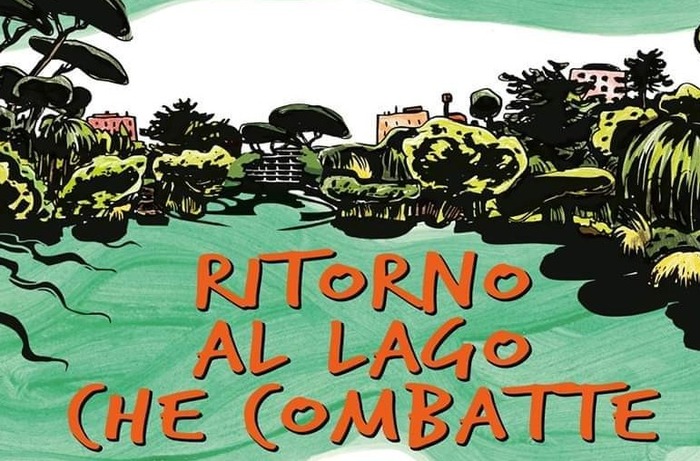"All changes, even the most longed for, have their melancholy because what we leave behind is part of us. We must die to one life before we can enter another." The French Anatole France opens one of the great venues of the Venice Architecture Biennale, the former Arsenal, demonstrating that the curator of this 18th edition, the Ghanaian architect Lesley Lokko, is a woman of letters. And action.
Lokko, who, unable to make a living as a designer, decided to do so as a best-selling author of romance novels such as Saffron Skies, has shown with her own career how to turn luck and tradition around. Have you been able to convey that regenerating idea to an architecture festival that brings thousands of visitors to the most unique city in the world?
He has managed to change quite a few things. Half of the 89 official exhibitions of this Biennial are proposals by African architects or the African diaspora. What does that decision entail beyond ethnic justice? In the mouth of the Commissioner, the will to decolonise and decarbonise. See.
An image of the Spanish pavilion at the Venice Biennale.Matteo de Mayda. Courtesy: La Biennale di Venezia
Although this is an edition in which most of the great names of architecture – the bus of the vedettes that Oscar Tusquets said – are not present, Lokko herself claimed, in the press conference prior to the inauguration, that "not all teams are the same": three of her collaborators from Ghana could not travel because the Italian administration had not granted them a visa for fear that, If they enter, they will stay in the country.
Thus, it is still the power – this time the African – that tries to draw the "better world" that architecture wants to propose. This is a discipline that is difficult to dissociate from power, that is, from money. For this reason, the great exhibition among those curated by Lokko is dedicated to the future projects of the architect David Adjaye.
Son of Ghanaian diplomats born in Tanzania 56 years ago, trained in London, author of the Smithsonian Museum of African American History and Culture in Washington and with projects in Sydney, Abu Dhabi, New York or Ghana (101 hospitals to address public health), Adjaye is today the most powerful black architect in the world. It is the one that has built the most, although the Burkinabe Francis Kéré is the one recognized with a Pritzker prize. Why? Probably because the figure of Kéré – the only one in his village who had access to an education and who after doing so raised the money to build the first school there – is transformative and indicates another way forward for architecture. That is exactly what Lokko was looking for as a curator. And Keré himself, also included in the exhibition, explains it from his pavilion built with a mud wall and announced with the phrase: Nous faisons une vision et non une retrospective (We show a vision and not a retrospective). Using amphorae to cut skylights into the walls, Kéré recalls the future that may lie in the past, the traditions that connect craftsmanship and architecture when not all amphorae are plastic. This connection between art, crafts and architecture common throughout the African continent is underlined by Lokko awarding the Golden Lion to the trajectory to an author who has always worked like this: the Nigerian Demas Nwoko.
There are many interventions that weave the plot in which Lokko sews decarbonization and decolonization as a recipe for the future. Some reconsider, for example, building materials. Brazil has won the Golden Lion associating the land with the claim of territory, the reparation of history and the treatment given to the population of African origin, the majority of the country, point out the commissioners Gabriela de Matos and Paulo Tavares.
Brazilian Pavilion at the Venice Biennale. Matteo of Mayda. Courtesy: La Biennale di Venezia
The Nordic Pavilion also speaks of decolonization by paying tribute to the itinerant way of living and building accommodation of the indigenous Sami minority. With Sami shops and handicrafts, Sverre Fehn's exquisite pavilion is messy, it looks squatted. That image is also projected by the pavilion of Canada and even that of Catalonia, with a vindication of the ingenious architecture of the top blanket. This year's German pavilion does not exist: it is occupied by the material remains that remained from past interventions.
Alison Killing, for her part, demonstrates that the spatial analysis tools provided by architecture have been key to investigative journalism that uncovers the detention camps of Xinjiang, in China, where more than one million Uighurs, the Muslim ethnic group of Xinjiang, have died. It was a young law student, Shawn Zhang, now living in Canada, who discovered, using Google, that several hospitals and schools in the area had been turned into detention camps. Killing checked with architectural programs that had reinforced the structures, closed the openings and increased the surveillance systems.
In a macro-exhibition such as a Biennial, it is only possible to transmit a message by refining what you want to express. Architecture stops communicating when it is necessary to read endless texts to understand it or when it uses the screen to do something other than enter a building. That is the case of the Spanish pavilion, which with five splendid short films, addresses an essential theme: the relationship between food and the shape of cities. It is unquestionable that "by eating we digest territories", as the commissioners Eduardo Castillo-Vinuesa and Manuel Ocaña point out. But perhaps his proposal has both sociological and architectural. The magnificent photographs of Pedro Pegenaute and the short films filmed by teams of filmmakers and architects could well be exhibited in the other Venice Biennale, that of art.
There are many interventions that delve into the motto of the Biennial analyzing or even diagnosing. Like Spain, South Korea projects figures and images that recall what we get tired of reading in the press: either we act or we reach the end. That is why the proposals that Lokko asked for are in the pavilions that have assumed that in the sea of information that is a biennial the naked, the clear and even the simple is read more emphatically.
Image of the Nordic pavilion at the Venice Biennale. Matteo of Mayda. Courtesy: La Biennale di Venezia
Thus, the idea deployed in the Swiss pavilion is as simple as it is radical: undo part of its brick perimeter wall and join its enclosure to the one that Carlo Scarpa devised for Venezuela. With the bricks removed they have also built benches. That's it: reconversion and recycling. Along these lines, the curators of the Austrian pavilion, Hermann Czech and the AKT collective, go one step further. When their proposal to link their pavilion with the adjoining neighborhood of Sant'Elena was banned, they proposed to dedicate the money to build a bridge. The idea was approved and although today the works are paralyzed they have addressed in the Venetian microworld the great architectural problems of the planet.
With a population for the first time below 50,000 inhabitants, visitors, and the hotels that host us, have displaced the Venetian population, which can no longer afford to live in the central sestieri and must now do so in Mestre or Sant'Elena. Is the problem familiar to you?
Despite its uniqueness, Venice itself offers recipes for the future. For starters, there are no cars there. Few buildings show the transformative capacity of architecture like the basilica of San Giovanni e Paolo converted into a hospital, not to mention one of the venues of the Biennale: what was the arsenal of the maritime empire that was the Serenissima Republic.
Perhaps for this reason, the Vatican – which participated for the first time in the Biennial showing chapels designed by the great architects of the planet – is now doing so for the second time by the hand of Álvaro Siza. The Portuguese – who wanted to be a sculptor before an architect – has limited himself to showing his sculptures of men without attributes and inviting Studio Albori to plant an orchard on the island of San Giorgio Maggiore. There are there, in the grounds and cells of the monastery, the recipes for everything to change: the renaturalization of the city, the cession of the privileges of the church, citizen participation consuming and caring for the garden and the attention of the great architecture to the problems of the majority of the population. The laboratory for the future cannot be sown without faith.
You can follow BABELIA on Facebook and Twitter, or sign up here to receive our weekly newsletter.
Subscribe to continue reading
Read without limits
Read more
I'm already a subscriber











/cloudfront-eu-central-1.images.arcpublishing.com/prisa/KMEYMJKESBAZBE4MRBAM4TGHIQ.jpg)



